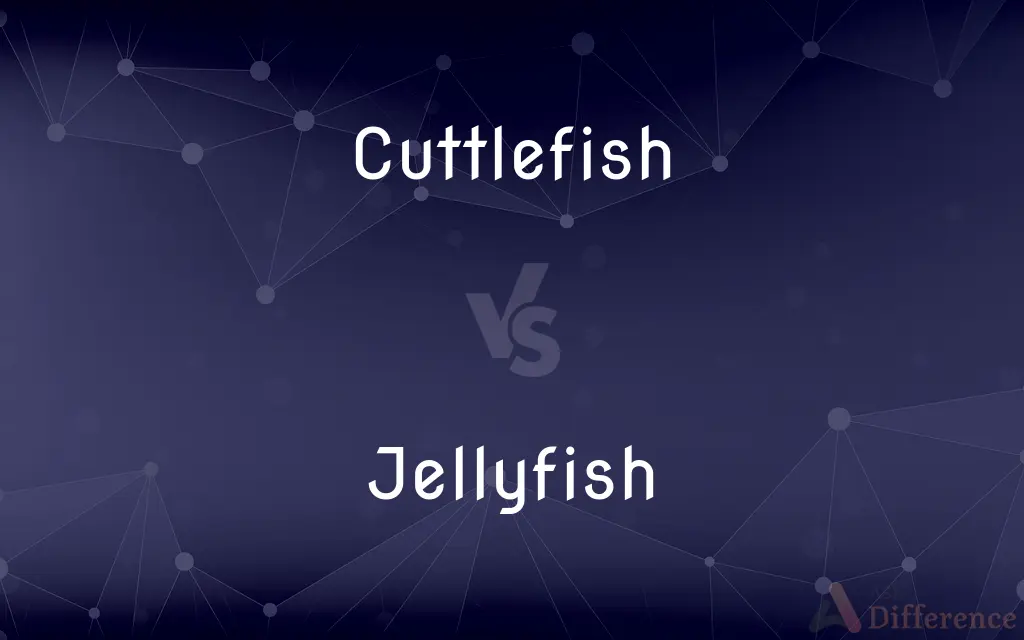Cuttlefish vs. Jellyfish — What's the Difference?
Edited by Tayyaba Rehman — By Urooj Arif — Updated on February 29, 2024
Cuttlefish are cephalopods with a unique internal shell and advanced camouflage abilities, known for their intelligence, while jellyfish are gelatinous zooplankton with tentacles, notable for their stinging cells used for capturing prey and defense.

Difference Between Cuttlefish and Jellyfish
Table of Contents
ADVERTISEMENT
Key Differences
Cuttlefish belong to the class Cephalopoda, which includes squids and octopuses, characterized by their bilateral body symmetry, distinct head, and tentacles. They possess an internal structure called the cuttlebone, used for buoyancy control. Jellyfish, on the other hand, are part of the phylum Cnidaria, which includes corals and sea anemones, and are known for their radial symmetry and a body composed mostly of water.
One of the most fascinating aspects of cuttlefish is their complex brain and sophisticated eyes, which grant them exceptional vision and the ability to communicate through changing skin color and texture. Jellyfish lack a centralized brain and complex eyes but have a simple nervous system that allows them to respond to environmental stimuli and control their movement in water.
Cuttlefish use their advanced camouflage ability to hide from predators and ambush prey, changing their skin color and pattern in seconds. Jellyfish, with their translucent bodies, rely on their stinging cells, or cnidocytes, to defend against predators and capture prey, releasing toxins that can range from mildly irritating to highly venomous.
The reproductive strategies also differ significantly; cuttlefish have a more complex mating behavior involving competition and display, while jellyfish undergo a two-stage life cycle that alternates between a sessile polyp stage and a free-swimming medusa stage.
Despite their differences, both cuttlefish and jellyfish play crucial roles in their respective ecosystems, with cuttlefish being predators that help control the population of smaller marine organisms, and jellyfish contributing to the oceanic food web and nutrient cycling.
ADVERTISEMENT
Comparison Chart
Classification
Cephalopoda
Cnidaria
Body Structure
Bilateral symmetry, internal shell (cuttlebone)
Radial symmetry, gelatinous body
Brain and Vision
Complex brain, sophisticated eyes
Simple nervous system, lacks complex eyes
Camouflage/Defense
Advanced camouflage abilities, can change color and texture
Stinging cells (cnidocytes) for defense and capturing prey
Reproduction
Complex mating behavior, direct fertilization
Two-stage life cycle (polyp and medusa), some species have strobilation
Habitat
Mostly found in ocean bottoms and coral reefs
Oceans worldwide, from surface waters to deep sea
Movement
Propels by jetting water, uses fins for steering
Drifts with currents, some can pulsate for movement
Diet
Carnivorous, feeds on small fish and invertebrates
Primarily feed on small plankton, fish eggs, and small fish
Compare with Definitions
Cuttlefish
A marine animal known for its ability to change skin color.
The cuttlefish camouflaged itself against the coral.
Jellyfish
A gelatinous zooplankton with stinging tentacles.
The jellyfish's tentacles can deliver a painful sting.
Cuttlefish
Uses ink as a defense mechanism.
The cuttlefish squirted ink to escape its predator.
Jellyfish
Part of the Cnidaria phylum.
Jellyfish share the phylum Cnidaria with corals and sea anemones.
Cuttlefish
Has an internal shell called a cuttlebone.
The cuttlebone helps cuttlefish regulate their buoyancy.
Jellyfish
Plays a vital role in the marine ecosystem.
Jellyfish contribute to the ocean's food web by feeding on plankton.
Cuttlefish
Exhibits complex behavior and communication.
Cuttlefish communicate through changing skin patterns.
Jellyfish
Lacks a central brain but has a simple nervous system.
Despite having no brain, jellyfish can navigate the oceans.
Cuttlefish
Belongs to the cephalopod family.
Cuttlefish, like octopuses, are intelligent cephalopods.
Jellyfish
Can reproduce through a polyp and medusa stage.
Jellyfish have a complex life cycle involving both reproduction.
Cuttlefish
Cuttlefish or cuttles are marine molluscs of the order Sepiida. They belong to the class Cephalopoda, which also includes squid, octopuses, and nautiluses.
Jellyfish
Jellyfish and sea jellies are the informal common names given to the medusa-phase of certain gelatinous members of the subphylum Medusozoa, a major part of the phylum Cnidaria. Jellyfish are mainly free-swimming marine animals with umbrella-shaped bells and trailing tentacles, although a few are anchored to the seabed by stalks rather than being mobile.
Cuttlefish
Any of various marine cephalopod mollusks of the family Sepiidae, having eight arms and two long tentacles, a calcareous internal shell, and a broad body.
Jellyfish
Any of numerous usually free-swimming marine cnidarians of the class Scyphozoa, characteristically having a gelatinous, tentacled, often bell-shaped medusa stage as the dominant phase of its life cycle. Also called true jellyfish.
Cuttlefish
Any of various squid-like cephalopods (marine mollusks) of the order Sepiida that have eight arms, two retractable tentacles, and a calcareous internal shell, and can eject a dark ink when threatened
Jellyfish
Any of various similar or related cnidarians.
Cuttlefish
Ten-armed oval-bodied cephalopod with narrow fins as long as the body and a large calcareous internal shell
Jellyfish
An almost transparent aquatic animal; any one of the acalephs, especially one of the larger species, having a jellylike appearance.
Jellyfish
Large siphonophore having a bladderlike float and stinging tentacles
Common Curiosities
How do cuttlefish camouflage themselves?
Cuttlefish can rapidly change their skin color and texture to blend into their surroundings, using this ability for hunting and protection.
What is a cuttlefish?
A cuttlefish is a marine cephalopod known for its intelligence, ability to change skin color for communication or camouflage, and internal shell called a cuttlebone.
Can cuttlefish and jellyfish be found in the same habitat?
While both can be found in marine environments, cuttlefish tend to inhabit ocean bottoms and coral reefs, whereas jellyfish are more widespread, from surface waters to the deep sea.
What distinguishes a jellyfish?
Jellyfish are gelatinous marine animals with a simple nervous system and tentacles equipped with stinging cells, part of the phylum Cnidaria.
Are cuttlefish considered more intelligent than jellyfish?
Yes, cuttlefish have a complex brain and exhibit behaviors indicating high intelligence, unlike jellyfish, which have a simpler nervous system.
Why do jellyfish sting?
Jellyfish use their stings to capture prey and defend against predators, with their tentacles releasing toxins when they come into contact with another organism.
What role do cuttlefish play in the ecosystem?
Cuttlefish are predators that help control the population of smaller marine organisms, maintaining ecological balance.
Can jellyfish be harmful to humans?
Some jellyfish species have stings that can be painful or even dangerous to humans, while others have mild or no effects.
How do jellyfish move?
Jellyfish primarily drift with ocean currents, but some can pulsate their bodies to navigate through the water.
Is a cuttlebone actually a bone?
No, a cuttlebone is not a true bone but an internal, porous structure made of aragonite used for buoyancy control in cuttlefish.
What do cuttlefish eat?
Cuttlefish are carnivorous, feeding on small fish, crabs, shrimp, and other invertebrates.
How do jellyfish reproduce?
Jellyfish have a two-stage life cycle involving reproduction in the medusa stage and reproduction in the polyp stage.
Can jellyfish be kept in aquariums?
Yes, jellyfish can be kept in specially designed aquariums that accommodate their unique needs and prevent them from getting stuck to filtration systems.
Are all jellyfish transparent?
While many jellyfish are translucent, some species have colorful or opaque bodies.
Do cuttlefish have predators?
Yes, cuttlefish have natural predators, including sharks, fish, and other cephalopods.
Share Your Discovery

Previous Comparison
Passional vs. Passionate
Next Comparison
Confirmation vs. PendingAuthor Spotlight
Written by
Urooj ArifUrooj is a skilled content writer at Ask Difference, known for her exceptional ability to simplify complex topics into engaging and informative content. With a passion for research and a flair for clear, concise writing, she consistently delivers articles that resonate with our diverse audience.
Edited by
Tayyaba RehmanTayyaba Rehman is a distinguished writer, currently serving as a primary contributor to askdifference.com. As a researcher in semantics and etymology, Tayyaba's passion for the complexity of languages and their distinctions has found a perfect home on the platform. Tayyaba delves into the intricacies of language, distinguishing between commonly confused words and phrases, thereby providing clarity for readers worldwide.
















































